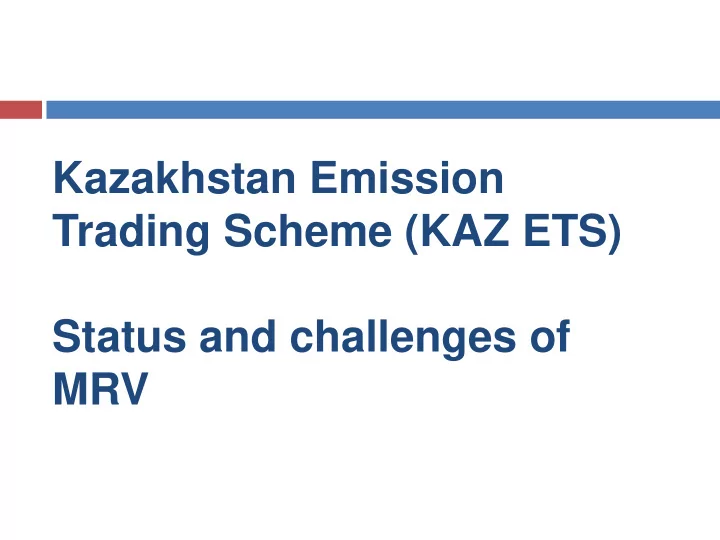

Kazakhstan Emission Trading Scheme (KAZ ETS) Status and challenges of MRV
KAZ ETS Summary Gases covered: only CO2 Threshold for inclusion: 20 000 tCO2/year Methane is subject to monitoring and methane reductions are eligible under the domestic offsets regulations Emissions trading scheme was first launched in 2013 (pilot phase) Second phase entered into force in 2014, covering 2014-2015 The first allowance transactions took place on March 2014 via the Caspian Trading Commodity (average price 455 KZT ~ 1.80 EUR)
Overall GHG emissions (excluding LULUCF) Emissions: 283 MtCO2e (2012)* Sector Name MtCO2e Energy (excl. Transport) 208 Transport 23 Industrial processes 28 Agriculture 2 * Data submitted to UNFCCC
National allocation plans Phase I Phase II Trading period 2013 2014-2015 Energy Energy Sectors covered Oil and gas Oil and gas Industry Industry Installations covered/companies 178 166 Historical Historical (mean of 2011-2012) Allocation principles (2010) Non-verified reports - 2011 Non-verified reports Verified reports -2012 Trade No trade So far 11 trades 0%-2014 Reduction obligation 0% 1.5%-2015 Number of free allowances tCO2 147 190 092 308 377 207
Enforcement Approx. 39.0 EUR/unit for non-compliance (calculated based on the Monthly Calculation Index (MCI)). In 2013, penalties for non-compliance were waived There are penalties for not submitting the required documents and reports to the Ministry
Monitoring, Reporting, Verification (MRV) Reporting is required for businesses or financial facilities above the threshold of 20,000 tCO2/year. Aside from CO2, reporting is also required for CH4 and N20 emissions. Reporting frequency: annually, with reporting is due on the 1 st of April. Emission data reports and their underlying data are to be verified by accredited third-party verifiers. Installations below the compliance threshold must submit non-verified inventory reports.
Review: Allocation, MRV, Compliance 1. Establishment 4. Reviewing 2. Preparation of 3. Verification of the of National of the the necessary documents Allocation Plan documents* documents 5. Approval of the 6. Issuance of 7. Entry in the installation GHG emission register passport allowances 9. Preparation 8. CO2 10. Verification of the 11. Submission of the reports monitoring reports of the reports on emissions Installation JSC «Zhasyl Verificator Legislative body operator Damu»
Monitoring plan The operator prepares and submits to the authorized body in the field of environmental protection an installation passport, including a monitoring plan for each installation.
Monitoring plan The monitoring plan should include the following information: 1) A list of sources of greenhouse gases, flow of raw resources and materials, where the monitoring greenhouse gas will be held by installation; 2) A description and justification of the method that will be used to monitor greenhouse gases (based on calculations or measurements); 3) A list of techniques that will be used to derive data about activity of greenhouse gases, emission factors, oxidation and conversion; 4) Identification of sources of information or a description of the methods for the determination of data about activity of greenhouse gases, emission factors, oxidation and conversion; 5) Description of methods of fuel sampling and materials for the determination of the calorific value of net values, the carbon content and emission factors, if they are calculated by the operator unit; 6) In the case of measuring systems - their description with their specifications, location, greenhouse gas fluxes and raw materials, to monitor where they will be used for, measurement errors, continuity or periodicity of measurements; 7) A description of the procedures for data collection and processing, quality control and quality assurance of the greenhouse gas inventory, distribution of responsibility for monitoring and reporting at the facility level
Monitoring plan The installation operator monitors greenhouse gases in accordance with the monitoring plan; The monitoring plan is used by the installation operator during the entire period of the certificate period on greenhouse gas emissions; The facility operator includes the results of monitoring greenhouse gas inventory in the annual report on the greenhouse gas inventory; Upon the results of verification by an independent accredited organization, a full report for the installation operator and the conclusion are compiled to be submitted to the authorized body in the field of environmental protection.
Monitoring plan Problems: Imperfection of forms of the inventory report and installation passports; The lack of clear and comprehensive advice on submitting the report on the inventory and installation passport; Absence of approved forms of results and report of the verification of GHG emissions; Absence of the standardized reporting forms for the verification process.
Strong focus on Developing more detail and clarity for monitoring(methodologies, templates, monitoring plans) Working on the reporting formats Working on formats of verification, and clarifying the requirements for verifiers Improving the arrangements for verifier accreditation to improve consistency (up to now – 10 verifier organizations accredited)
Key issues Single approach for all the operators of installations; Increasing the availability of verifiers to avoid high prices for verification along with toughening the requirements for verification; Development of sectoral benchmarks for future NAPs; Development and support of the ETS Registry.
Current work Work on the amendments to Ecocode is being carried out on the following areas: ◦ The list of sectors covered are defined more accurately; ◦ The threshold in the installed capacity of the energy sector is being determined; ◦ Improvement of the MRV framework; ◦ Toughening requirements for verification; ◦ Transition to e-reporting; ◦ Transition from grandfathering method of allocation to benchmarking is planned. Studying the existing carbon markets regarding the possibility of linking in the future
Thank you! Aigerim Yergabulova Climate change department Ministry of Energy, Republic of Kazakhstan a.yergabulova@energo.gov.kz
Recommend
More recommend